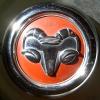-
Posts
5,720 -
Joined
-
Last visited
-
Days Won
61
Content Type
Links Directory
Profiles
Articles
Forums
Downloads
Store
Gallery
Blogs
Events
Classifieds
Posts posted by JBNeal
-
-
A decade of road-testing is plenty...
Those who think a formal education is a crowning achievement in one's life are sorely mistaken. Restoration of a unique antique automobile is THE crowning achievement...okay, getting married, having children, blah-blah-blah all that spiritual stuff is important too (and just as expensive).
What started as a photo-op for a diaper-clad red-head on the bumper of a '48 Dodge that had been in the family since new has progressed to the next big step of knocking the rust off and making the beast shiny again. I got it running after ten years of scraping cash & time together while blundering through high school & an engineering degree. Family squabbling ensued as the spoiled side of the family assumed this heirloom was 'given' to me in tip top shape and much peace-making diplomacy had to be pursued. Working through the Texas motor vehicle legal red tape of documented ownership was an exercise in patience & learning how to read disgruntled state employees. Debugging nagging carburetor & electrical problems was a good polishing of practical engineering fundamentals. Finding repair parts learned me real good on how to get creative with existing materials and a limited budget. In summary, many disciplines had to be mastered to bring this piece of American steel back to life.
Ten years ago, I got the '48 on the road, licensed, insured & inspected. Offended many folks when they offered to purchase my buggy for a miniscule fraction of the $$$ I had invested in it & I turned them down flat. I didn't want to do any cosmetic work until I had all the bugs worked out, and that finally happened last year when I replaced an intermittently foul-running carburetor with a NOS find from eBay and resolved the hot-starting problems. Didja know that even if the original big gauge cables look decent on the outside, that the indiviual strands corrode over time & build up a crippling resistance in the starter circuit? I sure didn't until I took some advice from the guy down at the starter & alternator shop.
The bias-ply tires are so worn now that they won't pass inspection, and it's been 10,000 miles on the rebuild, so everything has to be gone through per the shop manual directions. And the frame is bent from one of great-grandpa's three accidents he had before grandpa took the key away from him at the ripe old age of 90 back in '68. The bent frame has really showed up in the tire wear. Oil leaks are purt'near everwhar cuz of lack of properly located sealant in the motor & transmission areas. A couple of brake lines are weeping from inaccurate flaring technique. And I suspect the rear axle vent is plugged because of the gear oil that came out of the grease plug.
So I reckon it's time to take the next step and make Pappa's Dodge respectable. Doing research on this forum has really straightened me out on a lot of li'l odds & ends. Such as Wix 51010 oil filters that I've been using ain't right. The 218 Plymouth (!) that no one remembers having been swapped out has been running this filter since way back, cuz Dad remembers having to pull that messy perforated coffee can out when he was learning how to do his mechanic'n. There is a PCV system available for this motor, thanks to the P15-D24 downloads & member contributions. Setting the brake shoes can be done with a fabricated tool; bleeding the brakes can be done effectively by one person. And I can even jump start the 6V system with my Dodge diesel by simply disconnecting the charging circuit.
Let this be fair warning that I may be contacting a few of y'all for some technical information from time to time. I haven't committed this site's contents to memory yet, but I've read a majority of the threads & taken several pages of notes, cuz nobody likes to be asked a 'stupid' question. But I would like to thank all who have posted so far for providing a fountain of information.
When I did the initial mechanical restoration, I took plenty of pictures. Unfortunately, they were Polaroids that have since disappeared through a collection of mishaps. But I will be recording as much as I can this go around to go along with the documentation I've been collecting.
btw, the '49 1 ton went through a mishap last year thanks to Three-Tooth Timmy at the local tow truck establishment. Long story short, I have to replace the drag link, the steering box mounting bracket, and tie rods. Comparatively easy to accomplish...
Thank y'all again!
-
 2
2
-
-
I've been contemplating the pcv system for the flathead and recall something out of place on the 230 that's in my 1 ton. When I found it, it had a crankcase filter (looks like p/n 627488) and no draft pipe, although it looked like it had some sort of tube on it at some point. This filter is standard on big trucks for that year, as well as all export trucks. The guts of the draft pipe crankcase filter are very similar to the guts of the oil fill tube crankcase filter. I have replaced the draft pipe crankcase filter with a donor draft pipe just to match it to the setup on the 218 I have in my '48 1/2 ton.
I recall that Chrysler's pcv system on the 318, 360, etc. pulled vacuum from both banks of the V8. One bank had the pcv valve that used a vacuum port from the air cleaner body. The other bank had a crankcase filter that used a vacuum port form the throttle body.
Knowing this, I'm wondering if the flathead needs a filter between the pcv valve and the crankcase. I'm thinkin' that sludge might build up in the pcv valve & the lines and restrict vacuum.
Anyhow, the next time I'm at the parts store I'm gonna try to get some better ideas on what's available that could work. I'll post pics & p/n's with any 'breakthroughs'.
-
If the vacuum port is open, then the fuel mixture metered by the carb is being made too lean. Plug that port (I've used a brass hex head plug I found at the hardware store), readjust your carb to get the idle speed at its leanest mixture, and see what happens.



how to remove a truck from what was its final resting place?
in P15-D24 Forum
Posted
After removing several antique tractors from their resting places in black dirt with locked up wheels & axle shafts, I noticed a couple of things. First you want to break the wheels free from that cement-like clay by lifting them up out of the ground, with the skull-bustin' tractor jack or a front-end loader and a chain. Be sure to get everything clear of the ground; in this case, I'm concerned if any part of the frame/drive train is submerged. If the tires are shot & don't hold air, then dragging the locked up wheel will break the bead seal on that rotten rubber and the tire will spin on what is left of the rim. Go slow & steady, cuz jerkin' stuff around yields shockingly bad results...watched a purty hefty chain break, and the sling-shot action it took since it was under so much tension just barely missed the guys head on the tractor that was doin' the pulling.